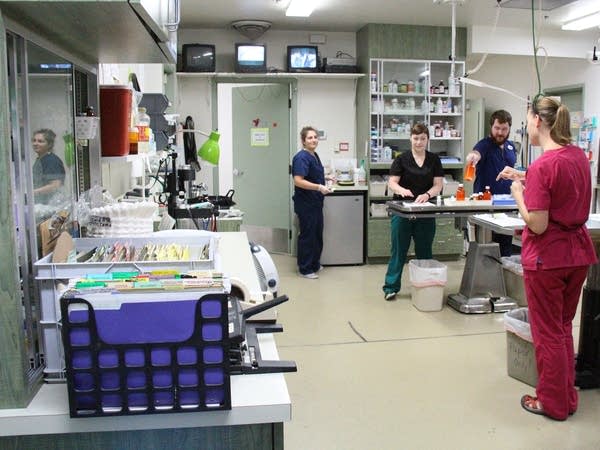How to keep birds from hitting the windows

Go Deeper.
Create an account or log in to save stories.
Like this?
Thanks for liking this story! We have added it to a list of your favorite stories.
Editor's note: In this installment of the MPR News Young Reporters Series, Ellen Bartyzal reports that it's not just the glass on large stadiums that presents a hazard to birds.
The small, gray nuthatch dropped off at the Wildlife Rehabilitation Center of Minnesota had flown into a house window earlier in the day and injured its wing. But it was lucky.
"I don't feel anything broken," said veterinarian Renee Schott as she placed the bird back in its cardboard box and ordered some pain medication to reduce swelling in its head. "If he looks normal tomorrow, he's flying away from us."

Schott's treated many bird concussions and shoulder fractures caused by window strikes. Some end up with injuries so severe she can't help them.
Turn Up Your Support
MPR News helps you turn down the noise and build shared understanding. Turn up your support for this public resource and keep trusted journalism accessible to all.
Researchers estimate that hundreds of millions of birds die in the U.S. each year after colliding with windows. Reflections confuse birds. Instead of seeing glass, they see trees, clouds and other objects reflected from their surroundings. They behave like the glass is invisible, said Daniel Klem Jr., an ornithology professor at Muhlenberg College in Allentown, Pa.
It's a problem claiming more birds as modern architecture uses more glass. Klem, though, believes the solution is pretty simple: glass should be made more visible to birds.
Window film, the same that's applied to transit bus windows for advertising, can be used to dull reflections. Or, glass panes can be treated to reflect ultraviolet light, which is easier for some birds to see.

Patterned glass is the most effective way to prevent bird collisions. The technique produces a frosted window effect. One method uses acid etching. Another involves bonding ceramic frit to glass.
Klem says any form of bird-protecting glass is better than none and should be considered in all new construction.
"These animals have been wonderful partners in assessing environmental health and teaching us about what we need to do to keep things healthy," he said. "We can fix this problem, it's just a matter of committing to do so."
Cost and aesthetic concerns have made it challenging to get those commitments from people. Bird-safe glass is more expensive than conventional glass. And some of the techniques that make glass visible to birds diminish the view for people.
Around homes, researchers say radical changes are often not necessary to make most windows safer for birds. They say adding a few inexpensive strings, decals or nets to a building's largest windows can significantly reduce bird collisions.
Longtime birder Jim Williams agrees more should be done to reduce bird collisions, although he feels conflicted. Williams says he hasn't bird-proofed his own windows, and he likes that his backyard feeders draw birds closer to his home.
"And if I put the feeders further out in the yard, that would probably be better too," said Williams, who writes the Wingnut blog in the Star Tribune. "But, I want them close enough to see them to watch what they are doing. I spend a lot of time watching them, learning from them."



